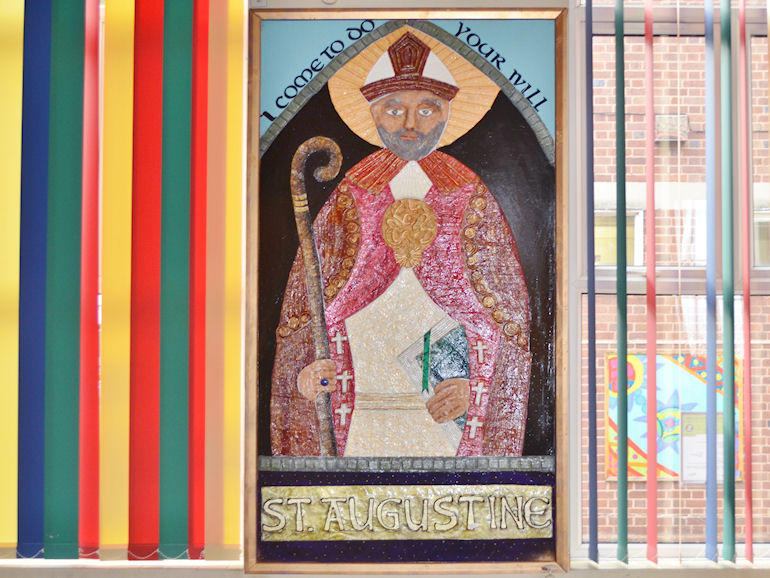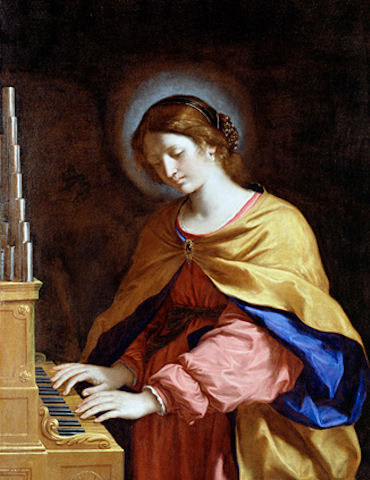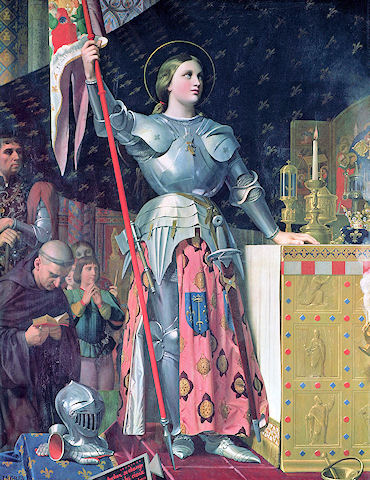Our Saints
Saint Augustine
Saint Augustine of Canterbury was a Benedictine monk, born in the 6th Century AD in Rome, Italy.
He became the first Archbishop of Canterbury in the year 597. He is considered to be the founder of the English Church.
When the Saxons first settled in Britain, they were all pagans and did not believe in God. The Pope who was in charge of all Christians at the time decided to send Augustine to England, to persuade all the Saxons to become Christians.
Saint Augustine crossed the English Channel and went to the palace of King Aethelbert of Kent in Canterbury. King Aethelbert was a pagan but his wife was a Christian. She was a Frank (from France). Augustine hoped she would welcome him. He was right. Augustine spoke to the King about the Bible. He persuaded Aethelbert to become a Christian. All Aethelbert’s people became Christians too.
Aethelbert gave Augustine lots of land. He built two large monasteries. The first was called Saint Augustine’s Abbey. The other one is Canterbury Cathedral.
Augustine is usually called ‘Saint Augustine of Canterbury’ and we should not mix him up with another famous man called ‘Saint Augustine of Hippo’ who is a completely different saint.
Later, missionaries went to other Saxon Kingdoms and persuaded them to become Christians too.

Saint Augustine
House Saints
Children in all classes are split into four house groups, named after the following Saints:
- Saint Catherine
- Saint Cecilia
- Saint Luke
- Saint Thomas
House points are awarded for all kinds of good work, helpfulness, special effort and achievement. A cup is awarded weekly to the best house and an annual cup is presented to the overall winner at the end of each year.
Various competitions are held during the year, such as Sports’ Days and other challenges, when children work in house teams to earn even more points.
House Captains and Vice-Captains are elected from Year 6 pupils by the children in each house.

Saint Catherine

Saint Cecilia

Saint Luke

Saint Thomas
Saint Catherine
Saint Catherine was born in Siena Benincasa, Italy, in 1347, into a very large family. She died in Rome in 1380.
When Catherine was 16 years old, she entered an order of nuns. Like many of the saints, Catherine knew great suffering.
In 1970, Pope Paul VI declared her a Doctor of the Church. She is also known as Co-Patroness of the City of Rome and Patroness of Italy.
Saint Cecilia
Saint Cecilia is the patroness of musicians and absolutely loved singing. It is known that when the musicians performed at her wedding, she ‘sang in her heart to the lord.’
Her feast day is celebrated in the Roman Catholic, Anglican, Eastern Orthodox, and Eastern Catholic Churches on 22 November.
She is also one of seven women named in part of the Mass.
She is known for being one of the most famous Roman martyrs. Her feast day has been celebrated since the fourth century.
Saint Luke
Saint Luke was born a Greek and a gentile in Antioch. Luke became a good friend of Saint Paul of Tarsus. He also accompanied him on his missionary journey. It is possible that Luke gave medical help to Paul when he had been beaten, stoned or nearly drowned while evangelising to the Western Roman Empire.
It is believed that Luke lived a long life and died at the age of 74 in Greece. He was the first Christian physician and was venerated by the Catholic Church as the patron saint of physicians and surgeons. Saint Luke is also considered the patron saint of painters because, according to tradition, he had painted images of Mary and of Jesus. This was later proven to be incorrect.
Saint Luke’s feast day is 18 October. We celebrate Saint Luke’s Day to remember what he did for his community and how he helped people.
Saint Thomas
Saint Thomas was born in Galilee in the 1st century.
He was a fisherman on Lake Galilee when Jesus called him to be one of his followers. The first time Thomas heard of Jesus’ resurrection he doubted it and his nickname was ‘Doubting Thomas’ because he didn’t believe Jesus had risen from the dead.
Saint Thomas’ name means ‘twin.’ His feast day is celebrated on the 3rd of July.
Class Saints
Each class has an allocated saint whose example they try to follow:
- Reception – Saint Andrew
- Year 1 – Saint Francis
- Year 2 – Saint Patrick
- Year 3 – Saint Joan of Arc
- Year 4 – Saint Bernadette
- Year 5 – Saint George
- Year 6 – Saint David
We also recognise other important saints whose lives help us to follow in Jesus’ footsteps.

Saint Andrew - Reception

Saint Francis of Assisi - Year 1

Saint Patrick - Year 2

Saint Joan of Arc - Year 3

Saint Bernadette - Year 4

Saint George - Year 5

Saint David - Year 6

Saint Mary, our Mother
Saint Andrew – Reception
Saint Andrew was a Galilean fisherman whose name means ‘strong’ and his feast day is celebrated on 30 November.
He was the brother of Saint Peter and became a Christian after Jesus called him.
Saint Andrew was one of the 12 apostles of Christ.
Saint Andrew is the Patron Saint of Scotland, Greece and Russia. There are approximately 450 churches in England named after Saint Andrew.
Saint Francis of Assisi – Year 1
Saint Francis was born in 1181 and died in 1226 aged 45. He was born and died in Assisi, a town near Rome.
He did not study very much. Francis did not easily find his vocation in life. He didn’t know what God was calling him to do. During his early life, he wasted a lot of his time spending money and having fun but he realised later on that he should give what he had to the poor. He ended up living a very poor life himself.
Francis followed the example of Jesus closely by living a simple life and teaching the Gospel message with great joy. The great Franciscan order of priests and brothers follows his simple lifestyle. Francis insisted that they should not own anything. He wanted his priests to love poverty as he did.
Saint Francis loved all creatures and the birds and animals happily obeyed his commands! As a reward for his great love, Jesus gave him his own wounds: two in his hands, two in his feet and one in his side.
Toward the end of his life, he became very sick. He was told he would live only a few more weeks and he exclaimed, “Welcome, Sister Death!” He asked to be laid on the ground and covered with an old habit.
He advised his brothers to love God, to love being poor and to obey the Gospel. “I have done my part,” he said. “May Jesus teach you to do yours.”
Francis died on 3 October, 1226.
Saint Patrick – Year 2
Saint Patrick was born in Great Britain during the 4th century. He was kidnapped and enslaved by Irish raiders when he was a teenager.
Although he was able to escape after six years and become a priest back in Britain, he chose to return to Ireland some years later to become a missionary. He wanted to help spread the teachings of Christianity to pagans.
Saint Patrick worked hard in Ireland despite the fact that pagan leaders did not want him there. He was not easily stopped and continued to teach people about Christianity for thirty years. He converted many people into Christians and promoted the building of schools, churches and monasteries.
Saint Patrick died on 17 March and was made a saint by the local church. He became the Patron Saint of Ireland. Saint Patrick’s Day is celebrated around the world but especially in Ireland.
Saint Joan of Arc – Year 3
Joan of Arc was born in 1412 in Domremy, France.
She was a kind, humble person. At the age of 13 she had mysterious visions and felt the voice of God. “I was thirteen when I heard a Voice from God for my help and guidance”. This is a quote from Joan of Arc.
She died at an early age (1412 to 1431).
She was burnt to her death because she believed in God and put her trust in God.
Saint Bernadette – Year 4
Bernadette Soubirous was born in a small town in France called Lourdes. Her family was very poor and everyone had to share one cold room. The only way to keep warm was to burn sticks which the children had to collect.
One cold winter’s day, Bernadette, her sister, Tionette, and her friend, Jeanne, were gathering firewood beside a river. They had been out all day and it was now growing dark. Tionette and Jeanne set off for home, crossing the icy cold river in their bare feet. Bernadette hesitated. She didn’t want to cross the river because it was so cold and she felt getting her feet wet might bring on her asthma.
As Bernadette went into the cave, suddenly she saw a beautiful lady with a sparkling silk veil and her face was dazzling in the moonlight. The lady called Bernadette over to her. Bernadette could not believe what she was seeing but she was not afraid. She knelt down and began to pray.
Some people said Bernadette was mad and laughed at her. Others said she was lying and shouted at her. She was slapped and spat upon. She was spoken to by her teacher, her priest, the local police and other important people who came all the way from Paris. All of these people wanted Bernadette to say that her vision of the beautiful lady was not real.
Bernadette answered all their questions in a quiet, gentle way. But she would not give up her belief that her vision of the beautiful lady was real.
Saint George – Year 5
Saint George is best known for being the patron saint of England. He showed bravery and courage for believing in God.
He is also the patron saint of Aragon, Catalonia, Ethiopia, Georgia, Greece, Lithuania, Palestine, Portugal, Russia, Amersfoort, Beirut, Bteghrine, Caceres, Ferrara, Freiburg, Genoa, Gozo, Pomorie, Lod and Moscow.
Saint George’s story is so full of mystery that it’s hard to tell if it’s a legend or a myth. The image of Saint George is that he is traditionally dressed in a white tunic with a red cross on the front. He is usually seen with a white horse.
Saint David – Year 6
Saint David was born in Wales in 500 AD. He died in 580 AD. He has been the patron saint of Wales since the 12th century.
The most famous story about Saint David tells how he was teaching a huge crowd about Jesus and he stood on a hill so the people had a better chance to hear him.
Saint David’s Day, 1 March, has been here since the 18th century. On that day, many people wear a daffodil which represents Wales. Children enjoy traditional welsh dances and have fun.
His mother was a saint and his teacher was one too. David was a Celtic monk and Bishop. During his life, he was the Archbishop of Wales and he was one of many early saints who helped to spread Christianity among the Celtic tribes of Western Britain.
Saint David’s flag has a black background with a yellow cross. On Saint David’s Day, children dress in their national costume which is made up of a tall black hat, white frilled cap and a long dress.
Saint Mary
Saint Mary, also known as our Mother, the Virgin Mary, is a lady that had no sin and that’s why God chose her to be Jesus’ mother. At first, Joseph didn’t believe Mary when she told him about the visit from the angel. To finally understand the truth Joseph needed to see the dreams of an angel telling him what had happened.
Saint Mary’s parents, Joachim and Anne, were loyal people in front of God. They prayed every night asking God to give them a child. Six years after they were married, they had welcomed Mary into their lives and they knew that she was a special gift from God.
When Mary was three years old, Joachim and Anne took her to the temple and gave their child to God. Mary spent nine years in the temple.
She was a wonderful mother to her son, Jesus. She also cares for each one of us.

